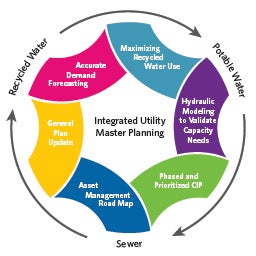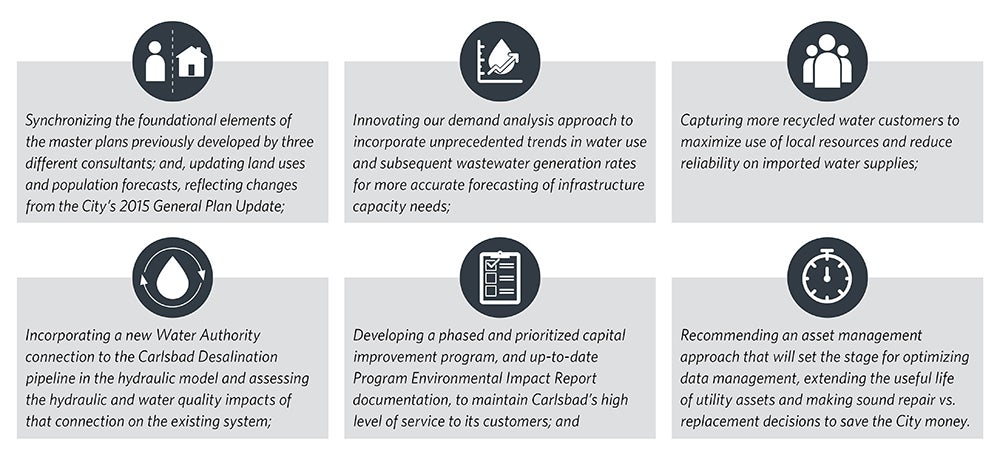
Utilities in Action: Providing Integrated Planning for a Sustainable Future
Integrated Planning
Carlsbad, California, is located 30 miles north of San Diego, along the Pacific Coast. It serves a population of approximately 115,000 people and is home to robust tourist and life sciences industries. The City of Carlsbad selected HDR to develop an integrated, sustainable master plan for three unique utilities: potable water, recycled water and sewer. From a One Water perspective, each utility has common foundational elements but very diverse challenges. Our team developed a basis of planning approach to streamline the foundational elements, freeing up resources to dig deeper into the diverse issues for each utility.
Basis of Planning Approach
Embracing the One Water concept, the integrated master plan “basis of planning” approach took into account local and regional planning issues, as well as state and federal standards, to keep Carlsbad on track for delivering high-quality utility services well into the future. It was critical that there was consistency among the data analyzed, assumptions made and basis of planning findings, so that the outcomes for each utility were compatible, reliable and defendable.
In a half-day workshop, we solicited discussions with stakeholders from a variety of City departments on the following topics to set the stage for the entire master planning project:
- Master Plan goals and objectives
- Demand Forecasting tools and approach
- Water Supply parameters and level of service goals
- Hydraulic Modeling Approach/Design and Planning Criteria
- Regulatory issues of concern
- Local or interagency opportunities and constraints
- Integration of Master Planning elements with Asset Management and Operations

Carlsbad’s past master plans were independently developed in the 2009-2011 time frame, prior to the economic recession and extended drought conditions that have highly influenced local water use. Key objectives addressed and integrated in the master plan updates included:

Demand and Flow Forecasting
Our team developed a customized, interactive, Excel-based forecasting tool designed to support scenario planning and sensitivity analysis for a range of potable water, recycled water, and wastewater future conditions. The Demand Forecast Model has the ability to evaluate the following key components:
- Identify Historical Water Usage Trends. The model uses historical water billing data to analyze past usage patterns. These usage trends can be analyzed for Carlsbad’s service area (to study the entire distribution system’s annual water usage, non-revenue water, etc.) or disaggregated by land use or pressure zones. The model also gives the user the ability to select a particular year or multiple years to analyze water usage based on these criteria.
- Apply Demand Tool Variables. Various user-defined variables can be applied to develop future water demand projections. These include population growth, water conservation, weather, baseline year demand variability, and growth rate adjustment.
- Develop Demand Projections. This module is used for developing future water demand projections by analyzing historical demand trends and applying user-selected variables to be incorporated. The future projections are based on a bracketed approach and provide curves for high, medium, and low scenarios, as selected by the user. This bookend approach helps to compare various what-if scenarios to help plan for uncertainties in the future.

Water demand projections used the year 2014 as the starting point, prior to state-mandated water conservation put in effect in 2015 and 2016 which severely curtailed water use in the region. The median water demand forecast of 20,700 acre-feet per year or 18.5 million gallons per day at buildout was determined to be the basis for the Master Plan and future capacity analysis of the water distribution system and supply system. Although the water and sewer service areas do not exactly align, approximately 45% of the City’s water use returns to the sewer system. At buildout, the Carlsbad sewer service area is forecasted to produce 8.5 mgd of sewage (Figure 1).
The City has the capacity to divert and recycle up to 7 mgd of treated sewage from the regional Encina Wastewater Treatment Plant for use in the City’s recycled water system. Carlsbad has been using recycled water since 2004 and has increased recycled water use to 4 mgd. The City is in the process of implementing its Phase III recycled water system expansion, which will increase usage to almost 5 mgd. Projected average day demands fall within the Carlsbad Water Reclamation Plant’s capacity of 7 mgd, and with storage available at Mahr Reservoir, the City can meet peak seasonal demands.
Integration of Master Planning elements with Asset Management and Operations
Another focus of the master planning effort was asset management and operations of these three utilities. The replacement cost of this infrastructure is estimated to be over $2.1 billion. As the system continues to age and deteriorate, the City seeks to sustain high levels of service at acceptable levels of risk, while minimizing cost.
The Asset Management Plan provides a strong foundation for condition assessment and capital improvement program planning that aligns with and supports the 2018 Potable Water, Recycled Water and Sewer Master Plan Updates (Master Plan Updates). The capacity of wastewater, water and recycled water systems is becoming less of a driver for capital improvements due to conservation and flattening growth forecasts, as the City approaches buildout. In contrast, the system conditions have become a more significant driver for capital improvements. As the systems age and deteriorate the City will need to increase investments in condition-related capital improvements and continue to implement asset management strategies to proactively maintain or improve service levels.
Carlsbad is in the process of installing asset management lifecycle software to forecast replacement and renewal projects. We helped the City to customize the decision logic, based on a combination of existing City decision-making processes, staff input, and industry experience, to provide a transparent, defensible, and consistent approach for decision makers to communicate risk, level of service, and cost to stakeholders. The decision logic is also used to develop high confidence risk mitigation forecasts.
During decision logic calibration, the business risk exposure thresholds that trigger specific risk mitigation recommendations (trenchless repair, replacement, etc.) were refined and set at the level necessary to balance cost and risk. These thresholds may be adjusted by the City over time as additional condition assessment data is gathered and the program is refined. Significant potential savings have been identified through the City’s asset management programs including the following:
- The cost to replace sewer pipes with moderate sags is approximately $4 million in capital investment. Eventually, these pipes will need to be replaced, but using a more frequent cleaning maintenance strategy to manage minor issues is extending the useful life of sewer pipes. This results in lower costs to ratepayers and fewer construction impacts to the community.
- Over the next five years, a condition and performance-based asset management approach will save the City approximately $2.6 million per year when compared to the age-based forecast for gravity sewer and manhole renewal.
- Over the next 50 years, a condition and performance-based asset management approach saves the City approximately$665 million dollars in unnecessary potable water and recycled water pipeline, valve and service replacement (an average of $13.3 million per year). The water renewal cost forecast is based on break rate and deterioration curves from regional utilities with similar water main infrastructure.
The capital improvement project recommendations developed as part of the Master Plan process provide planning information that identifies where system vulnerabilities exist. Through the Master Plan process, it was determined that the proposed capital improvement projects would not result in any environmental impacts that have not already been addressed in the prior Program Environmental Impact Report, and no new mitigation measures are required. The City is committed to continuing to operate and maintain high performing water, recycled water and sewer systems, and ensuring that critical facilities are properly financed to support the health and safety of our community.
A One Water Planning approach helps Carlsbad navigate future capital improvements, regulatory issues and regional opportunities.

Though California State of Emergency drought conservation measures have ended, long-term conservation regulations have been introduced for consideration by the State Legislature. Assembly Bill 1668 and Senate Bill 606 both entitled “Water Management Planning” were introduced in 2017 mandating the adoption of long-term standards for efficient use of water and performance measures for commercial, industrial and institutional water use before June of 2021. Other proposed legislation is targeting the reduction of sewer flows to ocean outfalls. With regional systems in place, Carlsbad coordinates with neighboring agencies to supplement water supply, sewage treatment and recycled water production. By adopting a One Water, basis of planning approach to their utility master planning, Carlsbad has an integrated understanding of the impacts of water conservation on available sewer flows and recycled water supplies and can potentially benefit from regional project opportunities to address these new regulations.




